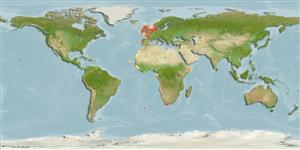Common names from other countries
Classification / Names / Names
ชื่อสามัญ | ชื่อพ้อง | Catalog of Fishes (gen., sp.) | ITIS | CoL | WoRMS
Environment: milieu / climate zone / depth range / distribution range
นิเวศวิทยา
; ระดับความลึก 0 - 80 m (Ref. 104052). Temperate
Eastern Atlantic and the Mediterranean: from the North Sea to Morocco and Bay of Biscay, extending southwards to Namibia including off lying islands.
Length at first maturity / ขนาด / น้ำหนัก / Age
Maturity: Lm 13.0 range ? - ? cm Max length : 22.0 cm CL เพศผู้/กระเทย; (Ref. 104052)
Maximum depth from Ref. 115714. Juveniles about to reach maturity live in shallow waters from 10 to 15 m deep on rocky and sandy substrates (Ref. 115713). They are also found on sandy bottoms colonized by Zostera marina. During summer, adults live near the shore on rocky areas. In winter, they are spotted on rocky bottoms and heterogeneous coarse sediments in deep waters. Both juveniles and adults during summer are found on muddy sands with few rocks (Ref. 115714). Uses slow, small-scale, non-directional movements. Exhibiting ontogenetic movements, juveniles live at depth of 5 to 15 m; adults then migrate to deeper waters (>50 m), where they mate (Ref. 115713). Diet remains to be accurately described. Studies (i.e. direct field observations, laboratory experiments, and gut content analyses) have suggested the species to have an omnivorous diet based on consumption of prey commonly found in their habitat (Ref. 115714). In one study, however, it was considered a mobile carnivorous species (Ref. 96498). Research using stable isotopes indicate no differences between sexes in diet or habitat use patterns either in adults (Refs. 115714, 115744) or juveniles (Refs. 115713, 115714, 115744).
Life cycle and mating behavior
วัยเจริญพันธุ์ | การสืบพันธุ์ | การวางไข่ | เซลสืบพันธ์ของเพศเมีย(ไข่) | ความดกของไข่ | ตัวอ่อน
Members of the order Decapoda are mostly gonochoric. Mating behavior: Precopulatory courtship ritual is common (through olfactory and tactile cues); usually indirect sperm transfer.
Le Pape, O., L. Baulier, A. Cloarec, J. Martin, F. Le Loc'h and Y. Désaunay. 2007. (Ref. 96498)
IUCN Red List Status (Ref. 130435)
CITES status (Ref. 108899)
Not Evaluated
Not Evaluated
Threat to humans
Harmless
Human uses
การประมง: การค้า
| FishSource |
เครื่องมือ
ข้อมูลเพิ่มเติม
Age/SizeการเจริญเติบโตLength-weightLength-lengthสัณฐานวิทยาตัวอ่อนอุดมสมบรูณ์
แหล่งที่มาจากอินเตอร์เน็ต
Estimates based on models
ความสามารถในการกลับคืนสู่ปกติ
ความสูง, เวลาต่ำสุดที่จะทำให้ประชากรเพิ่มขึ้นเป็น 2 เท่าใช้เวลาน้อยกว่า 15 เดือน (Fec=300,000).
